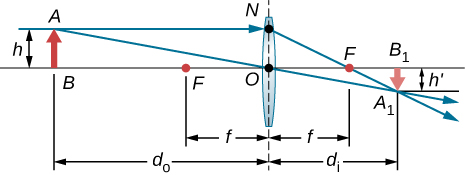| << Chapter < Page | Chapter >> Page > |
Use another ray-tracing diagram for the same situation as given in the previous problem to derive the thin-lens equation, .

Triangles
BAO and
are similar triangles. Thus,
.Triangles
NOF and
are similar triangles. Thus,
. Noting that
gives
or
. Inverting this gives
Equating the two expressions for the ratio
gives
. Dividing through by
gives
or
.
You photograph a 2.0-m-tall person with a camera that has a 5.0 cm-focal length lens. The image on the film must be no more than 2.0 cm high. (a) What is the closest distance the person can stand to the lens? (b) For this distance, what should be the distance from the lens to the film?
Find the focal length of a thin plano-convex lens. The front surface of this lens is flat, and the rear surface has a radius of curvature of . Assume that the index of refraction of the lens is 1.5.
70 cm
Find the focal length of a meniscus lens with and . Assume that the index of refraction of the lens is 1.5.
A nearsighted man cannot see objects clearly beyond 20 cm from his eyes. How close must he stand to a mirror in order to see what he is doing when he shaves?
The plane mirror has an infinite focal point, so that . The total apparent distance of the man in the mirror will be his actual distance, plus the apparent image distance, or . If this distance must be less than 20 cm, he should stand at .
A mother sees that her child’s contact lens prescription is 0.750 D. What is the child’s near point?
Repeat the previous problem for glasses that are 2.20 cm from the eyes.
Here we want . If near point, . Thus, . Using gives , so the near point is 25.3 cm.
The contact-lens prescription for a nearsighted person is −4.00 D and the person has a far point of 22.5 cm. What is the power of the tear layer between the cornea and the lens if the correction is ideal, taking the tear layer into account?
Unreasonable Results A boy has a near point of 50 cm and a far point of 500 cm. Will a −4.00 D lens correct his far point to infinity?
Assuming a lens at 2.00 cm from the boy’s eye, the image distance must be For an infinite-distance object, the required power is . Therefore, the lens will correct the nearsightedness.
Find the angular magnification of an image by a magnifying glass of if the object is placed from the lens and the lens is close to the eye.
Let objective and eyepiece of a compound microscope have focal lengths of 2.5 cm and 10 cm, respectively and be separated by 12 cm. A object is placed 6.0 cm from the objective. How large is the virtual image formed by the objective-eyepiece system?
Draw rays to scale to locate the image at the retina if the eye lens has a focal length 2.5 cm and the near point is 24 cm. ( Hint : Place an object at the near point.)
The objective and the eyepiece of a microscope have the focal lengths 3 cm and 10 cm respectively. Decide about the distance between the objective and the eyepiece if we need a magnification from the objective/eyepiece compound system.
Use, . The image distance for the objective is . Using gives . We want this image to be at the focal point of the eyepiece so that the eyepiece forms an image at infinity for comfortable viewing. Thus, the distance d between the lenses should be .
A far-sighted person has a near point of 100 cm. How far in front or behind the retina does the image of an object placed 25 cm from the eye form? Use the cornea to retina distance of 2.5 cm.
A near-sighted person has afar point of 80 cm. (a) What kind of corrective lens the person will need if the lens is to be placed 1.5 cm from the eye? (b) What would be the power of the contact lens needed? Assume distance to contact lens from the eye to be zero.
a. focal length of the corrective lens ; b. −1.25 D
In a reflecting telescope the objective is a concave mirror of radius of curvature 2 m and an eyepiece is a convex lens of focal length 5 cm. Find the apparent size of a 25-m tree at a distance of 10 km that you would perceive when looking through the telescope.
Two stars that are apart are viewed by a telescope and found to be separated by an angle of . If the eyepiece of the telescope has a focal length of 1.5 cm and the objective has a focal length of 3 meters, how far away are the stars from the observer?
What is the angular size of the Moon if viewed from a binocular that has a focal length of 1.2 cm for the eyepiece and a focal length of 8 cm for the objective? Use the radius of the moon and the distance of the moon from the observer to be .
An unknown planet at a distance of from Earth is observed by a telescope that has a focal length of the eyepiece of 1 cm and a focal length of the objective of 1 m. If the far away planet is seen to subtend an angle of at the eyepiece, what is the size of the planet?

Notification Switch
Would you like to follow the 'University physics volume 3' conversation and receive update notifications?